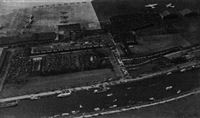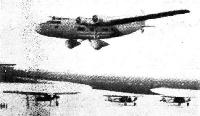
Описание
Страна : Нидерланды
Год : 1934
Транспортный самолет с экипажем из четырех человек
Fokker F.XXXVI (F.36)
F.XXXVI (с 1936 года - F.36) стал первым четырехмоторным самолетом фирмы "Fokker", он является самым большим самолетом голландской конструкции. Самолет с экипажем из четырех человек предназначен для перевозки 32 пассажиров. Проект выполнен согласно требованиям авиаперевозчика KLM к комфортабельному и надежному авиалайнеру для использования на линиях, связывающих Голландию и Вест-Индию. К моменту формулировки требований "Fokker" уже работала над небольшим четырехмоторным авиалайнером, но от дальнейшего его проектирования отказались в пользу разработки более крупного F.XXXVI. Первый полет прототип с четырьмя звездообразными моторами Wright SGR-1820-F2 Cyclone мощностью по 750 л. с. и с трехлопастными металлическими винтами выполнил в июне 1934 года. Двигатели установлены в индивидуальных мотогондолах, смонтированных на крыле. Конструкция F.XXXVI типична для "Fokker" того периода и несколько архаична в сравнении с конструкцией американских авиалайнеров, таких как Douglas DC-2.
Каркас фюзеляжа овального сечения сварен из стальных труб и, за исключением носовой части, обшит фанерой. Кабина экипажа размещена над пассажирской, которая разделена на четыре салона; имеется кухня, отделение для стюардов, два гардероба. Каркас хвостового оперения изготовлен из стальных труб и обтянут полотном. Высокорасположенное деревянное крыло имеет фанерную обшивку, механизация крыла состоит из закрылков и элеронов. Шасси неубираемое, с хвостовой опорой.
Хотя KLM планировала закупить шесть самолетов, фактически она прибрела только самую первую машину, так как самолет на фоне купленных компанией DC-2 являлся откровенно устаревшим. Авиакомпания KLM эксплуатировала лайнер на европейских линиях, пока не продала его в сентябре 1939 года компании "Scottish Aviation", которая передала его в 12-ю авиашколу первоначального обучения в качестве учебно-штурманского самолета. В то время возникла острая нехватка в штурманах-навигаторах, именно по этой причине "Scottish Aviation" закупила F.36 и два F.22 - F.36 разбился на взлете в мае 1940 года.
Надо отметить, что накануне Второй мировой войны "Fokker" проектировала авиалайнеры F.XXXVII и F.LVI. Проектирование цельнометаллического моноплана F.XXXVII (F.37) с четырьмя моторами Cyclone мощностью по 750 л.с. началось в 1937 году. Самолет был рассчитан на перевозку 32 пассажиров днем или 16 - ночью. F.LVI (F.56) также проектировался в 1937 году как цельнометаллический моноплан с силовой установкой из четырех моторов Hispano-Suiza для перевозки 56 пассажиров днем или 28 пассажиров ночью.
ТАКТИКО-ТЕХНИЧЕСКИЕ ХАРАКТЕРИСТИКИ
Fokker F. XXXVI (F.36)
Тип: транспортный самолет с экипажем из четырех человек
Силовая установка: четыре звездообразных мотора Wright SGR-1820-F2 Cyclone мощностью по 750 л. с.
Летные характеристики: максимальная скорость на оптимальной высоте 290 км/ч; практический потолок 4400 м; дальность 1350 км
Масса: пустого 9900 кг; максимальная взлетная 16 500 кг
Размеры: размах крыла 33,00 м; длина 24,00 м; высота 6,00 м; площадь крыла 170,00 м2
Полезная нагрузка: до 32 пассажиров по восемь человек в каждом из четырех салонов
Описание:
- Fokker F.XXXVI (F.36)
- Fokker F.XXII (F.22)
- Flight, July 1934
THE FOKKER F. XXXVI
Фотографии
-
Мировая Авиация 136
Регистрационный номер: PH-AJA [7], G-AFZR [7] "Arend"(орел) - единственный F.XXXVI, который летал на линии компании KLM Берлин - Лондон через Амстердам. Первую посадку в Британии самолет выполнил 28 сентября 1934 года, в 1939 году получил британскую регистрацию G-AFZR.
-
Aeroplane Monthly 1985-03 / J.Stroud - Wings of Peace
Регистрационный номер: PH-AJQ The F.XXII PH-AJQ Kwikstaart taking off from Rotterdam. This aircraft was lost in a crash at Schiphol on July 14, 1935.
-
Aeroplane Monthly 1985-03 / J.Stroud - Wings of Peace
Регистрационный номер: PH-AJR [4], G-AFXR [4], HM159 [4] Fokker F.XXII PH-AJR Roerdomp (Bittern), which went into service with KLM in 1935.
-
Air Enthusiast 1971-11 / ??? - The Fokker Fours
Регистрационный номер: PH-AJR [4], G-AFXR [4], HM159 [4] The Fokker F.22 PH-AJR in KLM colours.
-
Мировая Авиация 136
Регистрационный номер: PH-AJR [4], G-AFXR [4], HM159 [4] Конструкция F.XXII типична для "Fokker", каркас фюзеляжа овального сечения изготовлен из стальных труб и обтянут полотном.
-
Air Enthusiast 1971-11 / ??? - The Fokker Fours
Регистрационный номер: SE-ABA [7] The first F.22, SE-ABA, used by A B Aerotransport, had minor differences from the KLM version.
-
Flight 1935-01 / Flight
Регистрационный номер: SE-ABA [7] FOR A.B. AERO-TRANSPORT: The first of the new Fokker F22S (four P. and W. 525 h.p. "Wasps,") which has successfully passed its tests. Three of these 23-passenger machines will also be supplied to K.L.M.
-
Aeroplane Monthly 1985-03 / J.Stroud - Wings of Peace
Регистрационный номер: SE-ABA [7] AB Aerotransport's F.XXII SE-ABA Lappland.
-
Jane's All the World Aircraft 1980 / Encyclopedia of Aviation - Aircraft A-Z - v3
Регистрационный номер: SE-ABA [7] Fokker F.XXII.
-
Aeroplane Monthly 1985-03 / J.Stroud - Wings of Peace
Регистрационный номер: SE-ABA [7] The first arrivals at Bromma Airport, Stockholm, when it opened in May 1936 were ABA’s F.XXII Lappland and KLM’s Douglas DC-2 PH-AKS Sperwer (Sparrowhawk).
Другие самолёты на фотографии: Douglas DC-1 / DC-2 / C-32 / C-39 - США - 1933
-
Flight 1936-05 / Flight
Регистрационный номер: SE-ABA [7] Scene from the display at the new Stockholm aerodrome last Sunday. Flags of all nations taking part were generously displayed.
-
Aeroplane Monthly 1988-04 / Personal album. Civil
Регистрационный номер: G-AFXR [4], HM159 [4], PH-AJR [4] Fokker F.XXII G-AFXR was one of two of these Dutch airliners to find their way onto the British register. Initially flown by British American Air Services from Heston, 'XR was later acquired by Scottish Aviation at Prestwick, who already had G-AFZP. In October 1941 the Fokker was impressed and used as a navigation trainer, becoming HM159 and bearing the name Brontosaurus. On July 3, 1943 it crashed into Loch Tarbert and exploded. Originally 'XR formed part of KLM’s fleet, flying as PH-AJP (PH-AJR ???) and named Papegaai. It was powered by four 525 h.p. Pratt and Whitney radials and had an all-up weight of 28,000lb.
-
Aeroplane Monthly 1985-03 / J.Stroud - Wings of Peace
Регистрационный номер: G-AFZP [4], PH-AJP [4] F.XXII G-AFZP, in Scottish Airlines livery at Prestwick, was the first F.XXII, PH-AJP Papegaai.
-
Air Enthusiast 1971-11 / ??? - The Fokker Fours
Регистрационный номер: G-AFZP [4], PH-AJP [4] The last of the four-engined Fokkers, F.22 G-AFZP, at Prestwick in 1946.
-
Air Enthusiast 1971-11 / ??? - The Fokker Fours
Регистрационный номер: G-AFZP [4], PH-AJP [4] The Fokker F.22 G-AFZP at Prestwick in 1940, after modification while in service with No 12 EFTS operated by Scottish Aviation. Most noticeable modification is the extension of window area in the cabin. Compasses for use by the student navigators can be seen within the cabin, and the unusual style of fin flash is well shown in this picture.
-
Flight 1940-02 / Flight
Service transport: The most practised student of aircraft identification may be stumped by the R.A.F. machine into the capacious fuselage of which supplies are being loaded for delivery to an isolated post. It is a Fokker four-engined F.22.
-
Flight 1939-06 / Flight
SUMMER AT SCHIPHOL: This aerial view of Amsterdam's airport gives an idea of the tremendous number of people who are encouraged to come out during the weekend and on fine evenings in the summer. On the tarmac axe half a dozen assorted Douglas while on the right are F.22’s and F-36’s, which are now used for joy riding. The Schiphol runway extensions to the north are now complete.
Другие самолёты на фотографии: Douglas DC-3 / C-47 Skytrain/С-53 Skytrooper / Dakota - США - 1935
-
Air Enthusiast 1971-11 / ??? - The Fokker Fours
Регистрационный номер: G-AFZR [7], PH-AJA [7] This line-up at Prestwick in December 1939 shows the two F.22s and (distinguished by its three-bladed propellers, nearest the camera) the sole F.36.
-
Aeroplane Monthly 1981-03 / R.Nesbit - Navigator's progress (1)
Регистрационный номер: G-AFZR [7], PH-AJA [7] Both the Fokker F.XXII and F.XXXVI were used as navigational trainers by No 1 Air Observer's Navigational School at Prestwick.
-
Flight 1935-05 / Flight
FLAPS DOWN: The K.L.M. F.36, which, with the A.B. Aerotransport F.22, was on demonstration at Croydon last Monday, coming in to land. The flap area and the chief pilot's view are noticeable features.
-
Flight 1934-07 / Flight
THIRTY-TWO PASSENGERS - 174 M.P.H.: The Fokker F.XXXVI is fitted with four Wright "Cyclone" engines which give it a top speed of about 174 m.p.h.
-
Jane's All the World Aircraft 1980 / Encyclopedia of Aviation - Aircraft A-Z - v3
Регистрационный номер: PH-AJA [7], G-AFZR [7] Fokker F.XXXVI.
-
Aeroplane Monthly 1985-03 / J.Stroud - Wings of Peace
Регистрационный номер: PH-AJA [7], G-AFZR [7] The F.XXXVI PH-AJA Arend at Schiphol. The lower fuselage and engine cowlings were blue. Like the F.XX, the F.XXXVI was a one-off.
-
Flight 1934-07 / Flight
SOMETHING LARGE AND NEW: Here is the recently-completed Fokker F.XXXVI 32-passenger monoplane for K.L.M., fitted with four Wright "Cyclone" engines. Actual performance figures are not yet available, but the estimated top speed is 168 m.p.h. and the cruising speed 142 m.p.h. The range at cruising speed is expected to be about 870 miles.
-
Flight 1934-09 / Flight
SOLIDITY: The great wing depth of the Fokker F.36 inspires confidence. It has searing accommodation for 32 passengers The Fokker single-seater fighter gives a good idea of the size of the F.36.
Другие самолёты на фотографии: Fokker D.XVII - Нидерланды - 1932
-
Air Enthusiast 1971-11 / ??? - The Fokker Fours
Регистрационный номер: PH-AJA [7], G-AFZR [7] The largest Fokker built in Holland, the F.36 PH-AJA, photographed in its original colours for KLM.
-
Aeroplane Monthly 1981-03 / R.Nesbit - Navigator's progress (1)
Регистрационный номер: G-AFZR [7], PH-AJA [7] Fokker F.XXXVI G-AFZR at Prestwick in 1939-40.
-
Flight 1934-10 / Flight
AT CROYDON: Mr. C. J. Melrose photographed beside his "Puss Moth" soon after his arrival. In the background the Fokker F.XXXVI can be seen.
Другие самолёты на фотографии: De Havilland Puss Moth / D.H.80 - Великобритания - 1929
-
Aeroplane Monthly 1985-03 / J.Stroud - Wings of Peace
The 108ft 3in one-piece wing of the Fokker F.XXXVI is seen at right before covering of the upper surface. Note the solid ply rib webs.
-
Aeroplane Monthly 1985-03 / J.Stroud - Wings of Peace
IN THE F.22: The disposition of the pilots' seats in the Fokker F.22 is interesting in that the commander is provided with a perfect view on each side, while the first officer has a view which is little worse than that provided for each pilot in the conventional layout.
The flight deck of a KLM F.XXII. The captain's seat is in the centre, with the second pilot's to starboard. At a lower level to port is part of the radio operator's seat. -
Flight 1934-07 / Flight
LONG-DISTANCE COMFORT: On the left is shown a compartment of the new Fokker equipped for flying by day, and on the right the same arranged for night travel.
-
Air-Britain Archive 1983-02
Регистрационный номер: SE-ABA [7] A Fokker F.XXII SE-ABA which crashed on take-off at Malmo on 9.6.36.
-
Flight 1933-12 / Flight
The Fokker F.22, four "Wasp" TIDI engines.
-
Aeroplane Monthly 1985-03 / J.Stroud - Wings of Peace
Регистрационный номер: PH-AJP [4], G-AFZP [4] F.XXII PH-AJP Papegaai, the subject of KEITH WOODCOCK'S painting.
-
Air Enthusiast 1971-11 / ??? - The Fokker Fours
Fokker F.22
-
Air Enthusiast 1971-11 / ??? - The Fokker Fours
The Fokker F.22 in the form in which it was delivered to AR Aerotransport.
- Фотографии



































